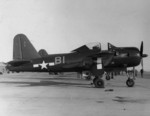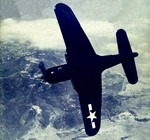FR Fireball
| Country | United States |
| Manufacturer | Ryan Aeronautical Company |
| Primary Role | Jet Fighter |
| Maiden Flight | 25 June 1944 |
Contributor: C. Peter Chen
ww2dbaseIn 1943, US Navy admiral John S. McCain, Sr. began a program for naval piston-jet mixed-powered fighters, and Ryan Aeronautical soon received the contract to build three prototype aircraft. In Dec 1943, before the first prototype aircraft took flight, the contract was expanded to 100 examples. The first two prototype aircraft were delivered in Apr 1944. The first piston-powered flight took place on 25 Jun 1944; in fact, this first prototype only had its nose-mounted piston engine installed, while the space behind the pilot in the fuselage, where the jet engine was supposed to be installed, was empty. Stability problems caused by mis-calculated center of gravity, however, thus enlarged vertical and horizontal stabilizers were designed and retrofitted to the prototype aircraft. Carrier suitability testing began in Jan 1945, and it was generally successful, though some small tweaks were made to the design as the result. By the spring of 1945, all three prototype aircraft were destroyed in separate crashes; the first two were victims of weak wing structure, while the third crashed after its canopy blew off during flight. In Mar 1945, the US Navy squadron VF-66 was equipped with its first batch of FR Fireball fighters, and in May the pilots qualified for carrier operations. By the time they were readied for combat, WW2 had come to an end. The squadron was decommissioned in Oct 1945, and the aircraft were transferred to squadron VF-41. On 6 Nov 1945, while attempting to make a landing aboard escort carrier USS Wake Island, a FR Fireball fighter's piston engine failed, thus forcing the pilot to use jet power in the landing process, the first landing of its kind in history. Production ended in 1945; a total of 71 aircraft, including the three prototype fighters, were built. Experience between 1946 and 1947 showed that FR Fireball fighters were too fragile to endure repeated carrier landings, thus they were withdrawn from service in Aug 1947. The aircraft ultimately proved to lack the structural strength required for operations aboard aircraft carriers and was withdrawn in mid-1947. Most of these aircraft, US Navy's first using jet-power, were scrapped shortly afterwards.
ww2dbaseSource: Wikipedia
Last Major Revision: Nov 2012
FR Fireball Timeline
| 11 Feb 1943 | Ryan Aeronautical received a US Navy contract to build three piston-jet mix-powered prototype fighters. |
| 2 Dec 1943 | The US Navy expanded the piston-jet mix-powered fighter contract with Ryan Aeronautical to 100 examples. |
| 25 Jun 1944 | The FR Fireball piston-jet mix-powered fighter took its first flight with only the piston engine equipped. |
| 20 Sep 1944 | The FR Fireball fighter took its first piston-jet mix-powered flight. |
| 13 Oct 1944 | The first FR Fireball prototype aircraft was destroyed in a crash at Naval Air Station China Lake, California, United States. |
| 31 Jan 1945 | The US Navy expanded the piston-jet mix-powered fighter contract with Ryan Aeronautical to 700 examples. |
| 25 Mar 1945 | The second FR Fireball prototype aircraft was destroyed in a crash. |
| 5 Apr 1945 | The third FR Fireball prototype aircraft was destroyed in a crash over Lindbergh Field, San Diego, California, United States. |
| 1 May 1945 | Pilots of US Navy squadron VF-66, flying FR Fireball piston-jet mix-powered fighters, flew qualifying missions from USS Ranger; two aircraft were damaged while landing. |
| 18 Oct 1945 | US Navy squadron VF-66, flying FR Fireball piston-jet mix-powered fighters, was decommissioned before ever seeing combat. |
| 6 Nov 1945 | A FR Fireball piston-jet mix-powered fighter became the first aircraft to land on an aircraft carrier (USS Wake Island) while using jet power. |
| 1 Aug 1947 | FR Fireball piston-jet mix-powered fighters were withdrawn from service by the US Navy. |
SPECIFICATIONS
FR-1
| Machinery | One General Electric J31-GE-3 turbojet rated at 1,600 lbf; one Wright R-1820-72W Cyclone radial engine rated at 1,350 hp |
| Armament | 4x12.7mm M2 Browning machine guns, 2x454kg bombs, 8x127mm rockets |
| Crew | 1 |
| Span | 12.19 m |
| Length | 12.19 m |
| Height | 4.24 m |
| Wing Area | 25.60 m² |
| Weight, Empty | 3,488 kg |
| Weight, Loaded | 5,285 kg |
| Speed, Maximum | 650 km/h |
| Speed, Cruising | 246 km/h |
| Rate of Climb | 9.00 m/s |
| Service Ceiling | 13,137 m |
| Range, Maximum | 2,610 km |
Photographs
 |  |  |  |
Did you enjoy this article or find this article helpful? If so, please consider supporting us on Patreon. Even $1 per month will go a long way! Thank you. Share this article with your friends: Stay updated with WW2DB: |
- » Wreck of USS Edsall Found (14 Nov 2024)
- » Autumn 2024 Fundraiser (7 Nov 2024)
- » Nobel Peace Prize for the Atomic Bomb Survivors Organization (11 Oct 2024)
- » Wreck of USS Stewart/DD-224 Found (2 Oct 2024)
- » See all news
- » 1,150 biographies
- » 337 events
- » 43,917 timeline entries
- » 1,241 ships
- » 350 aircraft models
- » 207 vehicle models
- » 374 weapon models
- » 123 historical documents
- » 260 facilities
- » 470 book reviews
- » 28,541 photos
- » 432 maps
Joachim von Ribbentrop, German Foreign Minister, Aug 1939
Please consider supporting us on Patreon. Even $1 a month will go a long way. Thank you!
Or, please support us by purchasing some WW2DB merchandise at TeeSpring, Thank you!